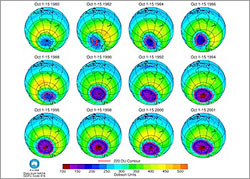Untitled Document
 |
The hole in the ozone layer
above Antarctica in satellite images |
The hole in the ozone layer above Antarctica has grown to near-record
size this year, suggesting 20 years of pollution controls have so far had little
effect, the United Nations said.
In a bulletin on Friday on the seasonal depletion of ozone gas, which filters
harmful ultraviolet radiation that can cause skin cancer and cataracts, the
UN's World Meteorological Organisation (WMO) said the hole would peak within
a couple of weeks.
"It will probably not break any records, but it shows that ozone depletion
is going on and that the so-called ozone recovery has yet to be confirmed,"
Geir Braathen, WMO's top ozone expert, told a news briefing.
US scientists reported last month that the ozone layer has stopped shrinking
but it will take decades to start recovering.
Warnings
The hole above the South Pole and Antarctica, which spans about 27 million sq
km, was expected to grow another million sq km in a week, bringing it close
to the record years of 2000 and 2003, the WMO said.
It had passed over Ushuaia, in the Patagonia region of southern Argentina, "leading
to noticeable increases in UV (ultraviolet)" radiation, according to the
bulletin, issued on the International Day for the Preservation of the Ozone Layer.
Chlorofluorocarbons (CFCs) containing chlorine and bromine, have been blamed for
thinning the layer because they attack the ozone molecules, causing them to break
apart.
Many CFCs, once commonly used in refrigeration, air-conditioning and industrial
cleaning, were banned by the Vienna Convention, signed exactly 20 years ago, and
its Montreal Protocol clinched in 1987.
Most scientists say the hole spanned a record 29 million sq km in September 2003,
exposing the southern tip of South America.
States obligations
quot;You could say that the ozone situation is stabilising at a low level.
We are approaching the maximum of ozone depletion, it is kind of levelling off,
but it is still too early to say that the situation is improving," Braathen
said.
In a statement, UN Secretary-General Kofi Annan said that the 189 states to
have ratified the Montreal Protocol had eliminated more than 1.5 million tonnes
of annual production of chemicals that destroy the ozone layer.
But developing countries were "only at the half-way point in many of their
obligations" under the pact, while in wealthy countries a number of chemicals
still needed to be phased out.
"It is essential that we remain alert to this hazard to avoid an increase
in skin cancers, cataracts and other health threats," Annan said.

